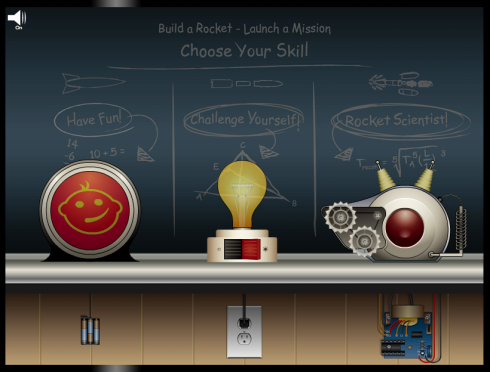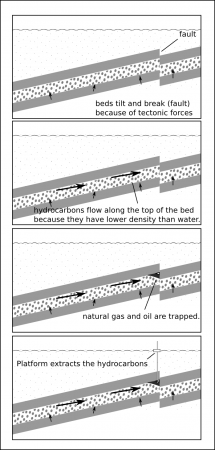
NASA has an interesting site that lets you assemble the rockets to launch some of their upcoming missions. It’s a good way to learn what NASA’s up to, and to learn about how NASA’s rockets work.
Middle and High School … from a Montessori Point of View
I’ve figured out how to put latex equations into this WordPress website, but have been struggling trying to get it on my other math based web pages, like the parabolas page.
Now, however, I’ve discovered CodeCogs, which provides an excellent Equation Editor that allows the inclusion of latex equations on any website (html page).
The following are my notes for the exercise that resulted in the Oil Traps and Deltas in the Sandbox post.
Crude oil is extracted from layers of sand that can be deep beneath the land surface, but it was not created there. Oil comes from organic material, dead plants and animals, that sink to the bottom of the ocean or large lakes. Since organic material is not very dense, it only reaches the bottom of ocean in calm places where there are not a lot of currents or waves that can mix it back into the water. In these calm places, other very small particles like clay can also settle down.

Over time, millions of years, this material gets buried beneath other sediments, compressing it and heating it up. Together the organic material and the clay form a type of sedimentary rock called shale. As the shale gets buried deeper and deeper and it gets hotter and hotter, and the organic matter gets cooked which causes it to release the chemical we know as natural gas (methane) and the mixture of organic chemicals we call crude oil (see the formation of oil and natural gas).

Shale beds tend to be pretty tightly packed, and they slowly release the oil and natural gas into the layers of sediment around them. If these layers are made of sandstone, where there is much more space for fluids to move between the grains of sand, the hydrocarbons will flow along the beds until they are trapped (Figure 2).
In this exercise, we will use the wave tank to simulate the formation of the geologic layers that produce oil.
For your observations, you will sketch what happens to the delta in the tank every time something significant changes.
1. How did changing the water level affect the formation of the delta.
- - - - - -
2. When you excavated the trench, did you observe the layers of different colored sand in the delta? Draw a diagram showing what you observed. Describe what you observed here.
- - - - - -
3. Was this a realistic simulation of the way oil reservoirs are formed. Please describe all of the things you think are accurate, and all of the things you think are not realistic?
- - - - - -
When organic material is buried it is compressed and “cooked” because the deeper you go beneath the surface of the earth the hotter it gets. This causes the breakdown of the organic matter and the production natural gas and oil. The stages of decomposition are:
Diagenesis:
Catagenesis:
Metagenesis:
A billion, in continental Europe is, a million squared ( 1,000,0002 = 1,000,000,000,000), but in the English speaking world, a billion is only a thousand million (1,000,000,000). numberphile goes into the beautiful, mathematical logic of the longer form (i.e. the continental system).
Of course, the “simplest” system, which avoids all the potential for miscommunication, is the standard scientific notation, where 1,000,000,000 is written as 1×109 (or just 109).
Students from the University of Leicester have published a beautiful short research paper (pdf) on the physics of curving a soccer ball through the air.
It has been found that the amount a football bends depends linearly on the speed of the ball and the amount of spin.
— Sandhu et al., 2011: How to score a goal (pdf) in the University of Leicester’s Journal of Physics Special Topics
They derive the relationship from Bernoulli’s equation using some pretty straightforward algebra. The force (F) perpendicular to the ball’s motion that causes it to curl is:
![]()
and the distance the ball curls can be calculated from:
![]()
where:
The paper itself is an excellent example of what a short, student research paper should look like. And there are number of neat followup projects that advanced, high-school, physics/calculus students could take on, such as: considering the vertical dimension — how much time it take for the ball to rise and fall over the wall; creating a model (VPython) of the motion of the ball; and adding in the slowing of the ball due to air friction.
New technology has a tendency to be used badly, but that does not mean it can’t be a powerful tool. Konstantin Kakaes argues that the increased use of technology is hurting science and math education.
A 2007 congressionally mandated study by the National Center for Educational Evaluation and Regional Assistance found that 16 of the best reading and mathematics learning software packages—selected by experts from 160 submissions—did not have a measurable effect on test scores.
— Kakaes (2012): Why Johnny Can’t Add Without a Calculator in Slate.
He makes some good points –a lot of technology is used employed simply because it’s “new technology” and not for what it can do– but I think he’s missing one fundamental aspect, probably because stuff is so new that we’re still figuring out how to use technology properly. The key missing aspect is that the increasing ubiquity of technology is changing who we are.
Technology is like an amplifier for our cognitive abilities –memorizing facts is less important because you can quickly look up the answers; how much time should you spend solving matricies if your can program your own matrix solver? –, and technology is becoming more closely integrated into who we are –we’re becoming inseparable from our smartphones (and it’s only a matter of time before they become implants).